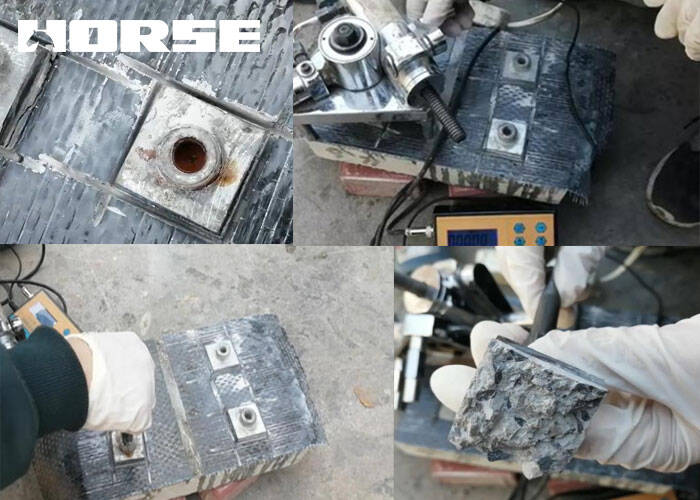Solutions
Horse Construction offers full range of structural strengthening materials with technical supports, documentation supports, products supports, project supports.
How to see the construction quality of carbon fiber sheet from the form of positive tension bond failure?

An important inspection item for the construction inspection of carbon fiber sheet paste is the positive tensile bond test between the carbon fiber composite material and the base material concrete.
It is worth noting that this is a compulsory inspection item, because the inspection is the most direct and convincing quantitative inspection method, and it is also the ultimate basis for project quality. Every carbon sheet pasting project in the actual project, regardless of the size of the project, must be sampled and inspected on site.
The standard for the test result of the sample includes two indicators: bond strength and failure mode. Let's talk about the specific forms of damage and how to determine that the inspection is qualified.
1. The bond strength should be greater than the specification index requirements and the concrete cohesive failure
| Test items | Measured concrete strength grade of original component | Test qualification index | Detection method | |
| Tensile bonding strength and its failure mode | C15-C20 | ≥1.5MPA | And cohesive failure of concrete | GB50550 |
| ≥C45 | ≥2.5MPA | |||
Note: If the test result is between C20~C45, the corresponding intensity level is determined by interpolation.
The inspection results meet the above-mentioned strength index requirements, and the damage occurs in the concrete base layer to be judged as qualified. If the bond strength is less than the specification index but the concrete is still cohesive failure, if it is not a single point incident, it means that the actual strength level of the base concrete may be different from the original design document. In addition, experimental studies have shown that the bond tensile strength of the concrete surface is generally lower than the axial tensile strength of the concrete. The difference between the construction quality of the paste and the low tensile strength of the original component concrete surface should be distinguished before conclusions can be made.
2. Cohesive failure of adhesive or fiber layer
(1) The damage occurred in the adhesive, indicating that there is a problem with the quality of the adhesive or the operator's improper use.
(2) The damage occurs to the fiber strands that have pores or free in the fiber layer. It is said that the pasting operation is improper, the gas is not exhausted or the adhesive does not fully infiltrate the fiber bundle.
The sample with adhesive or fiber layer cohesive failure can be judged as unqualified.
3. Interlayer destruction
(1) Adhesion failure between the adhesive layers indicates that the construction of the primer and the fiber adhesive layer at each level is not done in accordance with the specification construction requirements, for example, the primer is over-hardened and the fiber is not re-polished during construction.
(2) The damage occurred on the side of the concrete base, but only the surface mortar fell without the aggregate belt, indicating that the treatment of the concrete base was unqualified. When this happens, the test value of the positive tensile bond strength is very low, and it cannot be wrongly judged as concrete cohesive failure.
The sample with interlayer failure can be judged as unqualified.
4. Mixed destruction
The combination of multiple damage forms becomes mixed damage, which occurs from time to time during actual site inspections. When mixed failure occurs, the criterion for passing the inspection result is: the bonding strength is greater than the index requirement, and the area of the cohesive failure of the concrete accounts for more than 85% of the bonded area of the sample, otherwise it is unqualified.
The positive tensile bond strength test of fiber composite material and concrete is the guarantee of the quality of carbon fiber construction, but the same attention should be paid to the test:
1). This is a destructive test, and the measuring point should be selected outside the maximum force-bearing area.
2). When pasting the metal test block, ensure that the line of action of the force when the test block is pulled is perpendicular to the sticking surface.
3). It must be confirmed that the pre-cutting seam is deep enough into the concrete. Otherwise, the test results will be seriously biased due to fiber connection.
4). The damaged parts after inspection should be repaired in time.
You can find anything here you are in need of, have a trust trying on these products, you will find the big difference after that.

High strength, unidirectional carbon fiber wrap pre-saturated to form a carbon fiber reinforced polymer (CFRP) wrap used to strengthen structural concrete elements.

High strength carbon fiber reinforced polymer (CFRP) strip / laminate / plate for structural strengthening and concrete repair

High strength, unidirectional carbon fiber sheet pre-saturated to form a carbon fiber reinforced polymer (CFRP) sheet used to strengthen structural concrete elements.